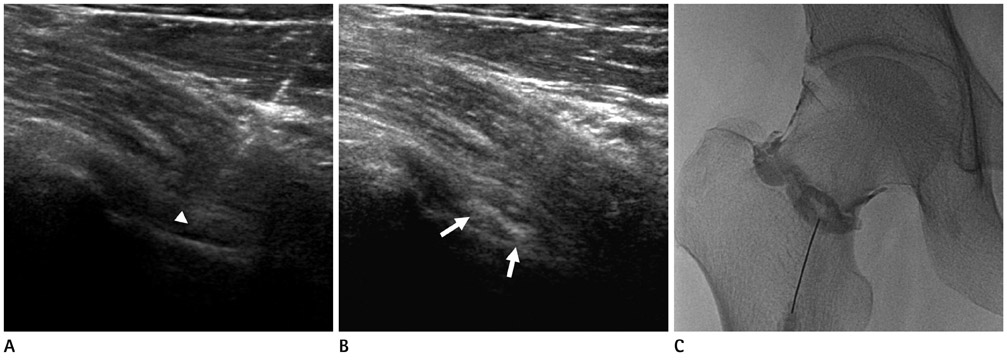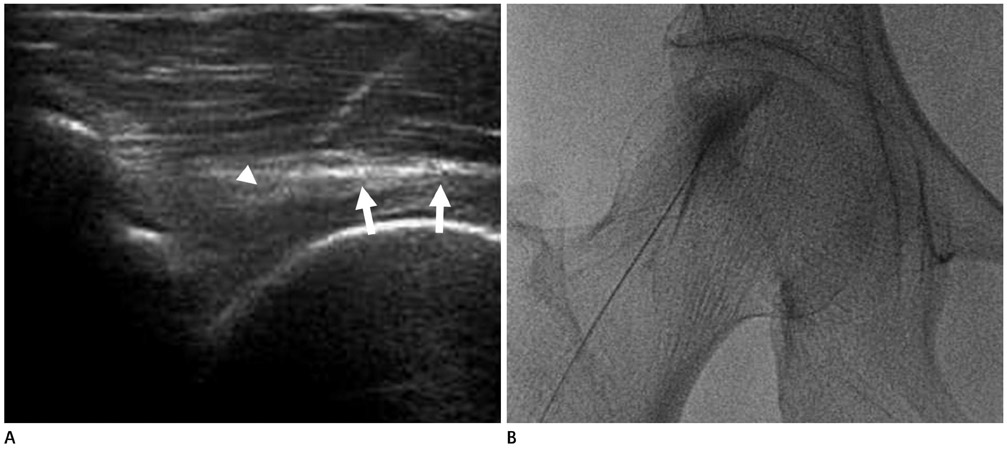J Korean Soc Radiol.
2013 Mar;68(3):237-243. 10.3348/jksr.2013.68.3.237.
The Effectiveness of Ultrasound-Guided Steroid Injection for Femoroacetabular Impingement: A Comparison between the Extra-Articular and Intra-Articular Approaches
- Affiliations
-
- 1Department of Radiology, Seoul National University Bundang Hospital, Seongnam, Korea.
- 2Department of Radiology, SMG-SNU Boramae Medical Center, Seoul, Korea. jaywony@gmail.com
- 3Department of Orthopaedic Surgery, Seoul National University Bundang Hospital, Seongnam, Korea.
- KMID: 1748458
- DOI: http://doi.org/10.3348/jksr.2013.68.3.237
Abstract
- PURPOSE
To assess the effectiveness of pain control using ultrasound-guided steroid injection by the extra-articular and intra-articular approaches to femoroacetabular impingement patients.
MATERIALS AND METHODS
From September through December 2010, 18 patients with clinical suspicion of femoroacetabular impingement syndrome underwent ultrasound-guided steroid and local anesthetics injection: a total of 20 cases, including 16 cases of ipsilateral and 2 cases of bilateral injection. Extra-articular or intra-articular approach was selected for each patient, randomly and alternately. Nine cases were performed by extra-articular approach and 11 cases were performed by intra-articular approach. Every patient was observed in the outpatient clinic and visual analogue scale (VAS) was taken and compared before and after the procedure in all patients.
RESULTS
Pre-injection average VAS value of extra-articular approached cases was 5.22 +/- 1.99 and post-injection average VAS value was 4.11 +/- 1.96, which is statistically insignificant (p < 0.156). The average VAS value of intra-articular approached cases was decreased from 5.72 +/- 2.15 to 2.91 +/- 2.30 after injection, which is statistically significant (p < 0.006).
CONCLUSION
Ultrasound guided intra-articular approached steroid and local anesthetics injection could be effective in controlling pain for patients with femoroacetabular impingement syndrome.
MeSH Terms
Figure
Reference
-
1. Tannast M, Siebenrock KA, Anderson SE. Femoroacetabular impingement: radiographic diagnosis--what the radiologist should know. AJR Am J Roentgenol. 2007. 188:1540–1552.2. Beall DP, Sweet CF, Martin HD, Lastine CL, Grayson DE, Ly JQ, et al. Imaging findings of femoroacetabular impingement syndrome. Skeletal Radiol. 2005. 34:691–701.3. Hwang DS, Nam DC, Yang JH, Kang TH. Usefulness of hip joint AP plain X-ray radiographs in femoroacetabular impingement. J Korean Hip Soc. 2007. 19:105–111.4. Şahin N, Atici T, Öztürk A, Özkaya G, Özkan Y, Avcu B. Prevalence of femoroacetabular impingement in asymptomatic contralateral hips in patients with unilateral idiopathic osteoarthritis. J Int Med Res. 2011. 39:790–797.5. Palmer WE. Femoroacetabular impingement: caution is warranted in making imaging-based assumptions and diagnoses. Radiology. 2010. 257:4–7.6. Clohisy JC, McClure JT. Treatment of anterior femoroacetabular impingement with combined hip arthroscopy and limited anterior decompression. Iowa Orthop J. 2005. 25:164–171.7. Lavigne M, Parvizi J, Beck M, Siebenrock KA, Ganz R, Leunig M. Anterior femoroacetabular impingement: part I. Techniques of joint preserving surgery. Clin Orthop Relat Res. 2004. 61–66.8. Crawford JR, Villar RN. Current concepts in the management of femoroacetabular impingement. J Bone Joint Surg Br. 2005. 87:1459–1462.9. Wisniewski SJ, Grogg B. Femoroacetabular impingement: an overlooked cause of hip pain. Am J Phys Med Rehabil. 2006. 85:546–549.10. Hart ES, Metkar US, Rebello GN, Grottkau BE. Femoroacetabular impingement in adolescents and young adults. Orthop Nurs. 2009. 28:117–124. quiz 125-126.11. Emara K, Samir W, Motasem el H, Ghafar KA. Conservative treatment for mild femoroacetabular impingement. J Orthop Surg (Hong Kong). 2011. 19:41–45.12. Ravaud P, Moulinier L, Giraudeau B, Ayral X, Guerin C, Noel E, et al. Effects of joint lavage and steroid injection in patients with osteoarthritis of the knee: results of a multicenter, randomized, controlled trial. Arthritis Rheum. 1999. 42:475–482.13. Favejee MM, Huisstede BM, Koes BW. Frozen shoulder: the effectiveness of conservative and surgical interventions--systematic review. Br J Sports Med. 2011. 45:49–56.14. Kivlan BR, Martin RL, Sekiya JK. Response to diagnostic injection in patients with femoroacetabular impingement, labral tears, chondral lesions, and extra-articular pathology. Arthroscopy. 2011. 27:619–627.15. Panzer S, Augat P, Esch U. CT assessment of herniation pits: prevalence, characteristics, and potential association with morphological predictors of femoroacetabular impingement. Eur Radiol. 2008. 18:1869–1875.16. Beck M, Kalhor M, Leunig M, Ganz R. Hip morphology influences the pattern of damage to the acetabular cartilage: femoroacetabular impingement as a cause of early osteoarthritis of the hip. J Bone Joint Surg Br. 2005. 87:1012–1018.17. Pfirrmann CW, Mengiardi B, Dora C, Kalberer F, Zanetti M, Hodler J. Cam and pincer femoroacetabular impingement: characteristic MR arthrographic findings in 50 patients. Radiology. 2006. 240:778–785.18. Kassarjian A, Yoon LS, Belzile E, Connolly SA, Millis MB, Palmer WE. Triad of MR arthrographic findings in patients with cam-type femoroacetabular impingement. Radiology. 2005. 236:588–592.19. Anderson SE, Siebenrock KA, Tannast M. Femoroacetabular impingement: evidence of an established hip abnormality. Radiology. 2010. 257:8–13.20. Murphy S, Tannast M, Kim YJ, Buly R, Millis MB. Debride ment of the adult hip for femoroacetabular impingement: indications and preliminary clinical results. Clin Orthop Relat Res. 2004. 178–181.21. Chang JS, Son HC, Park JH, Kim KH. Periacetabular osteotomy for acetabular retroversion: a case report. J Korean Hip Soc. 2003. 15:158–161.22. Hwang DS, Lee CH, Lee CH. Arthroscopic treatment of osseous abnormalities as a cause of femoroacetabular impingement: preliminary clinical results. J Korean Orthop Assoc. 2006. 41:778–784.23. Sung YB. Osteotomy around the hip: overview. J Korean Hip Soc. 2007. 19:236–239.24. Hwang DS, Nam DC, Yang JH. Arthroscopic treatment of osseous abnormalities as a cause of femoroacetabular impingement: preliminary clinical results. J Korean Hip Soc. 2007. 19:112–120.25. Byrd JW, Jones KS. Arthroscopic femoroplasty in the management of cam-type femoroacetabular impingement. Clin Orthop Relat Res. 2009. 467:739–746.26. Philippon MJ, Stubbs AJ, Schenker ML, Maxwell RB, Ganz R, Leunig M. Arthroscopic management of femoroacetabular impingement: osteoplasty technique and literature review. Am J Sports Med. 2007. 35:1571–1580.27. Ayeni OR, Wong I, Chien T, Musahl V, Kelly BT, Bhandari M. Surgical indications for arthroscopic management of femoroacetabular impingement. Arthroscopy. 2012. 28:1170–1179.28. Rebello G, Spencer S, Millis MB, Kim YJ. Surgical dislocation in the management of pediatric and adolescent hip deformity. Clin Orthop Relat Res. 2009. 467:724–731.29. Bardakos NV, Villar RN. Predictors of progression of osteoarthritis in femoroacetabular impingement: a radiological study with a minimum of ten years follow-up. J Bone Joint Surg Br. 2009. 91:162–169.30. Hartofilakidis G, Bardakos NV, Babis GC, Georgiades G. An examination of the association between different morphotypes of femoroacetabular impingement in asymptomatic subjects and the development of osteoarthritis of the hip. J Bone Joint Surg Br. 2011. 93:580–586.31. Espinosa N, Rothenfluh DA, Beck M, Ganz R, Leunig M. Treatment of femoro-acetabular impingement: preliminary results of labral refixation. J Bone Joint Surg Am. 2006. 88:925–935.
- Full Text Links
- Actions
-
Cited
- CITED
-
- Close
- Share
- Similar articles
-
- Efficacy of Intra-articular Steroid Injection in Patients with Femoroacetabular Impingement
- A Comparison between the Anterior and Posterior Approach to US-guided Shoulder Articular Injections for MR Arthrography
- Ultrasound Guidance for Intra-Articular Shoulder Injections for Frozen Shoulder
- Intra-Articular Injections in Patients with Femoroacetabular Impingement: a Prospective, Randomized, Double-blind, Cross-over Study
- Ultrasound-guided Intra-Articular Injections



